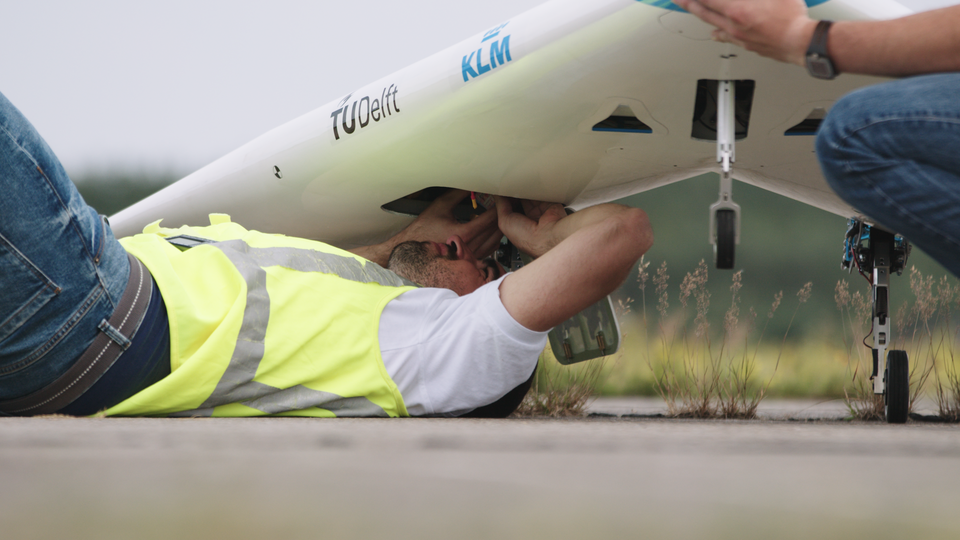Successful maiden flight for the TU Delft Flying-V
This summer, a team of researchers, engineers and a drone pilot of TU Delft travelled to an airbase in Germany for the first real test flight of the scaled flight model of the energy-efficient aircraft design called the Flying-V. The project was announced last year together with KLM. After a period of extensive wind tunnel testing and a series of ground tests in the Netherlands, it was time to perform the first flight and obtain an impression of the flight characteristics. The aircraft had a very successful maiden flight.
Project leader Dr Roelof Vos and his team of researchers and engineers took the 22.5 kg and 3 m wide scale model of the Flying-V for flight tests to a well-guarded airbase in Germany, where they could work together with a team from Airbus. The pilot’s task was to take-off, fly a number of test manoeuvres and approaches until the batteries were nearly empty and land. And he succeeded. Vos: “One of our worries was that the aircraft might have some difficulty lifting-off, since previous calculations had shown that ‘rotation’ could be an issue. The team optimized the scaled flight model to prevent the issue but the proof of the pudding is in the eating. You need to fly to know for sure.” Rotation on take-off was performed easily and occurred at a speed of 80 km/h. The plane’s thrust was good and flight speeds and angles were as predicted.
But testing new technology is never straightforward. The team had a challenging week in which they had to change the centre of gravity of the aircraft and fix the antenna to improve telemetry. The flight has now also confirmed that the current design still shows too much ‘Dutch roll’, causing a slightly rough landing. A next step for the team is to use the data collected during the flight for an aerodynamic (software) model of the aircraft. This will make it possible to programme it in a flight simulator to be used in future research , while further improving the flight characteristics. The team will also prepare the scale model for future flight tests.
The Flying-V
The Flying-V is a design for a highly energy-efficient long-distance aeroplane. The aircraft’s design integrates the passenger cabin, the cargo hold and the fuel tanks in the wings, creating a spectacular V-shape. Computer calculations have predicted that the aircraft’s improved aerodynamic shape and reduced weight will reduce fuel consumption by 20% compared to today’s most advanced aircraft. KLM has been a partner in the project since 2019. Also due to their support, the project team has been able to build this scale model. It was first presented at the 100th anniversary of KLM in October 2019. Various business partners are now involved in the project, including Airbus. Airbus is also an explicit supporter for the first flight. The partners are working together on a research plan to fine-tune the concept. Next step: providing the Flying-V with sustainable propulsion, taking into account that the design seems highly suitable to carry liquid hydrogen instead of kerosene.
More information
Webcast: On 1 September Dr. Roelof Vos and Prof. Henri Werij showed and explained what happened during the test week. Pieter Elbers, the CEO of KLM and Daniel Reckzeh, Senior Manager R&T in Airbus commented. The recording of the webcast can be viewed here: https://live.dutchwebinar.com/tudelftwebcastflyingv
Website: Detailed information about the flight tests, including videos and photos, will be made available on https://www.tudelft.nl/en/ae/flying-v/ on Tuesday 1 September.
Contact
Roelof Vos, project leader Flying-V TU Delft, +31 (0) 15 278 5643, r.vos@tudelft.nl
Ineke Boneschansker, press officer, +31 (0) 6 140 151 19, i.boneschansker@tudelft.nl
Inge Snijder, press officer, +31 (0) 6 147 595 17, i.snijder@tudelft.nl


